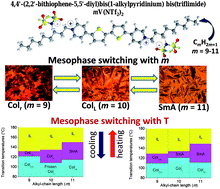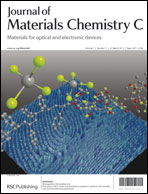Here we report the synthesis and the liquid crystalline properties of a new class of thienoviologen salts of the dication series 4,4′-(2,2′-bithiophene-5,5′-diyl)bis(1-alkylpyridinium)++ (mV++s) having different alkyl-chain lengths (m = 9–11). As determined by DSC, polarized optical microscopy and X-ray diffraction analyses, the anion of the salt plays a crucial role in disclosing the liquid crystalline nature of the mV++s. It is shown that the bis(triflimide) salts, mV(NTf2)2s, exhibit a unique bimesomorphic behaviour, self-segregating into columnar rectangular and/or smectic phases. Despite the rod-like shape of these π-extended viologen dications, columnar phases are obtained by the self-assembly of disk-like structures formed by the association of dications into dimers through bridging interacting anions. Interestingly, the bimesomorphism allows “switching” from a columnar to a calamitic phase and vice versa by changing the temperature and/or the alkyl-chain length. In particular, as the length of the alkyl chains increases from m = 9, where a stable rectangular columnar mesophase is observed, to m = 10, an incipient calamitic mesomorphism takes place which manifests itself with the formation of a lamello-columnar mesophase. This ultimately evolves toward a smectic A phase for m = 11.

You have access to this article
 Please wait while we load your content...
Something went wrong. Try again?
Please wait while we load your content...
Something went wrong. Try again?


 Please wait while we load your content...
Please wait while we load your content...